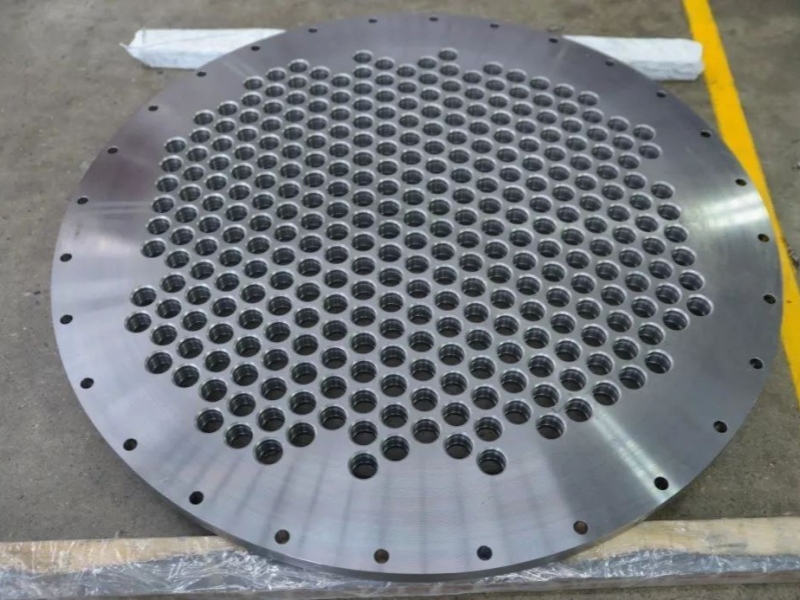
What Are You Looking For?
Normally, the base materials for metal clad plates are S235JR, Q235B, Q235R, Q345R, 15CrMoR, etc. The cladding materials include austenitic stainless steel, 2205, 2507, 904L, 254SMO, AL6XN, titanium and titanium alloys, nickel and nickel based alloys, copper, zirconium, and tantalum. Among them, zirconium clad plates and tantalum clad plates need to be equipped with transition layers, such as tantalum/ zirconium/ titanium steel clad plates: Ta1/R60702/TA1/Q345R, widely used in high concentration sulfuric acid and nitric acid.
In theory, all ductile special metals can be used to make clad plates. Metal clad plates have been widely used in coal chemical, petrochemical, fine chemical, fluorine chemical, PTA, chlor alkali, acetic anhydride, salt production, medicine, metallurgy, power and other fields. Wuxi Changrun have been supplied Titanium Steel Clad Tube Sheets, Copper Alloy Clad Tube Sheets and Nickel Steel Clad Tube Sheets to our clients.

How is metal clad plate made? There are two main methods for industrial production: explosive bonding and rolling bonding.
1.Explosive clad plates
The production process of explosive clad plates involves overlapping the clad layers on the base plate, with a certain distance between the clad layers and the base plate. The explosive is laid flat on top of the clad layer, and the energy generated by igniting the explosive causes the upper layer of the clad layer to impact the base plate at high speed, the instantaneous high temperature and high pressure enable the interface between the two materials to achieve solid-phase metallurgical welding bonding.
Under the ideal condition, the shear strength per square millimeter of the interface can reach 400 Mpa, which is sufficient for subsequent equipment processing needs. The production of explosive clad plates is generally carried out in remote outdoor factories, due to the working characteristics of explosives and weather requirements. This is a factor that affects its efficiency.
2.Rolling clad plates
Rolling clad plate is produced using a medium thick plate rolling mill or a hot strip rolling mill, with the base and clad layer in a physically pure state. During the rolling process, two metals diffuse to achieve complete metallurgical bonding. Of course, in order to improve the wetting effect of the composite interface and enhance the bonding strength, a series of technical measures need to be taken in the physical and chemical treatment of the interface. The rolling process enables the continuous and large-scale production of clad plates, which is not limited by weather conditions. Its main characteristics are high production efficiency, low cost, and large product size.
What are the process characteristics of explosive clad plates and rolling clad plates?
The characteristics of explosive clad:
1.Due to its cold processing, explosive bonding can produce various metal composite plates, such as titanium, copper, nickel, aluminum, and various non-ferrous metals.
2.Explosive bonding can produce metal clad plates with a total thickness of several hundred millimeters, such as seats for some large water conservancy projects and ultra thick tube sheets. But it is not suitable for producing thinner clad steel plates with a total thickness of less than 8 mm.
3.Explosive recombination is produced using the energy of explosives, which can cause noise, vibration, and smoke pollution to the environment. But the equipment investment is small, and there are only hundreds of explosion production plants of different sizes in China.
4.Both small-scale production and large-scale production are possible, such as two or three tube sheets and various combinations of irregular sizes. The covering layer can be spliced and polished first before exploding.
5.Due to the limitations of weather and other process conditions, the production efficiency of explosive bonding is relatively low.
The characteristics of rolling clad:
1.The production is carried out using large medium plate mills and hot continuous mills, resulting in high production efficiency and fast supply speed. The product size is large and the thickness can be freely selected. Stainless steel coating with a thickness of 0.5mm or more can be produced. But due to the high investment in equipment and rolling production lines, there are fewer manufacturers.
2.Due to the limitation of the compression ratio of steel rolling, it is not yet possible to produce clad steel plates with a thickness of 50mm or more in rolling production, and it is also inconvenient to produce various small batch, circular and special shaped composite plates.
3.The advantages of rolling clad plates are the thin specification clad plates of 6, 8, and 10 mm. Under hot rolling conditions, composite coil production can be achieved, and then the length can be determined according to the needs to meet more user needs.
It is not difficult to find that the two clad plates with different production processes have their own advantages and characteristics. Allowing users to reduce costs and use materials reasonably is fundamental. From a cost accounting perspective, rolling is calculated based on tonnage. And the explosion is calculated based on the explosion area. Industry professionals believe that the thicker the steel plate, the more advantages it has in explosive bonding, while the thinner the steel plate, the better the rolling bonding method.